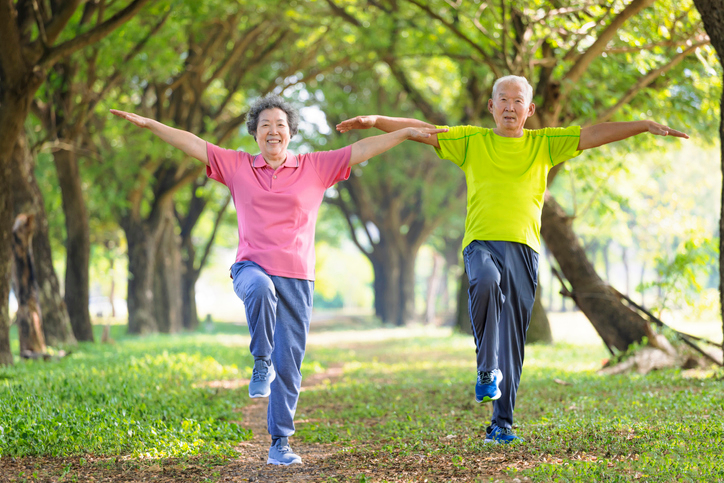Commitment + Clinical Leadership = Better Outcomes

How to Improve Your Balance and Prevent Falls
Each year, experts estimate that falls result in over 3,000 injuries treated in emergency departments, with at least 8,000 of those leading to hospitalizations. One-fourth of Americans over 65 are at risk for falls, making this a challenge many older Americans face.
Your body uses many different parts such as the legs, joints, muscles, and eyes to help you coordinate your balance. However, balance problems can occur due to aging or medical problems, which makes it important to learn how to keep your balance strong no matter how old you are.
Risk Factors for Losing Your Balance
Many things can cause you to lose your balance and fall. While there may not always be a single cause, some of the risk factors for falling include:
- Changes in your senses such as eyesight or hearing
- Conditions such as diabetes or heart disease
- Foot problems
- Reflexes are not as strong as they used to be
- Muscle weakness
- Low blood pressure
Many causes of falling revolve around conditions that could be the result of a lack of exercise and a healthy diet. A good diet combined with regular physical activity can keep your bones strong and prevent diseases commonly linked to balance problems.
Exercises to Help Improve Balance
There are a few exercises you can incorporate into your lifestyle to help strengthen your muscles and reduce your risk of losing your balance. Here are 5 exercises you or an older loved one can practice to improve balance.
Yoga
Yoga is a great exercise for improving balance because it involves moving from one pose to the next. This requires you to focus on aligning your body into the correct pose and using your body’s strength and weight to maneuver into it.
Yoga is proven to improve concentration, strengthen muscles, improve posture, and improve muscle coordination. Some of the poses that are found to be best for improving balance include the tree pose, side plank pose, eagle pose, and dolphin plank pose.
Walking
Another way you can improve your balance is by taking regular walks each day. Walking is a great exercise because it doesn’t require any money and is safe for most Americans.
Walking helps improve your lower body strength by building the muscles in your legs, which is essential for maintaining good balance. At least 150 minutes of walking a week should be your goal if you are looking to improve your balance.
Biking
Biking involves using your body’s strength, balance, and coordination to get from one place to another. Over time, regular cycling can improve your muscle strength and flexibility, joint mobility, bone strength, and posture.
Biking is also linked to decreasing your risk of arthritis and can help those who currently have arthritis improve their mobility. Biking can reduce joint pain and stiffness because it promotes range of motion in your hips and knees as well as strengthens the quadriceps muscles. Biking has also been proven to help improve balance in those with osteoarthritis, a condition that oftentimes affects the mobility of the knees and joints.
Tai Chi
Tai Chi is a Chinese exercise that involves slowly moving from one pose to another. Tai Chi can physically improve your strength, joint stability, and balance over time, and this exercise is proven to reduce falls in seniors by 45%.
There are different tai chi programs available depending on your age, interests, and physical capabilities. Tai Chi is also safe for most people to practice, even those who need to work their way into a standing position over time.
Strength Training
Strength training is another way you can improve your balance by preventing the natural loss of muscle mass. Around age 30, we lose 3-5% of lean muscle mass per decade, and less muscle mass can put you at risk for falls and fractures.
Strength training involves strengthening and toning the muscles against a resistant force. As your muscles increase in mass and strength, your balance will improve over time. While many people will use weights for strength training, you can do body-weight exercises at home such as squats, pushups, and planks to get started. There are also classes available if you prefer to have guidance from an expert.
When to See a Doctor
If you notice a sudden change in your balance or posture, you should consider seeing a doctor. Your doctor will let you know what might be the cause of your balance problems and can give you a proper diagnosis. You should also see a doctor if you notice any changes to your body after a fall, even if you don’t currently feel any pain from it.
There are different tests a doctor can use to test your balance, including balance tests, hearing and ear tests, and imaging tests such as an MRI. If they find any balance problems, they can recommend the proper treatment.
Start Improving Your Balance Today!
Now that you know some ways to improve your balance, you can start taking steps to strengthen your body and muscles to prevent falls in the future. Maintaining good balance throughout your life can help you protect yourself as you age.
Saber Healthcare is an organization dedicated to providing consultant services to long-term care providers. This article is for informational purposes and is not meant to be seen as professional advice. Please consult with a medical expert before relying on the information provided.
Sources
- https://www.ncoa.org/article/get-the-facts-on-falls-prevention
- https://www.mayoclinic.org/diseases-conditions/balance-problems/symptoms-causes/syc-20350474#:~:text=a%20fainting%20feeling.-,Loss%20of%20balance%20or%20unsteadiness,your%20legs%20(peripheral%20neuropathy).
- https://www.nia.nih.gov/health/prevent-falls-and-fractures
- https://www.trinityhearingandbalance.com/blog/how-to-improve-your-balance-with-yoga/#:~:text=Yoga%20helps%20with%20balance%2C%20focus,alignment%2C%20strength%2C%20and%20attention.
- https://www.health.harvard.edu/staying-healthy/improve-your-balance-by-walking#:~:text=A%20combination%20of%20activities%20such,important%20element%20of%20good%20balance.
- https://www.betterhealth.vic.gov.au/health/healthyliving/cycling-health-benefits
- https://www.mayoclinic.org/diseases-conditions/osteoarthritis/symptoms-causes/syc-20351925
- https://www.health.harvard.edu/blog/try-tai-chi-to-improve-balance-avoid-falls-201208235198#:~:text=Tai%20chi%20helps%20improve%20balance,'t%20physical%E2%80%94but%20emotional
- https://www.health.harvard.edu/staying-healthy/preserve-your-muscle-mass
- https://my.clevelandclinic.org/health/symptoms/21021-balance-problems#:~:text=Balance%20problems%20are%20the%20inability,a%20spinning%20or%20falling%20sensation).
